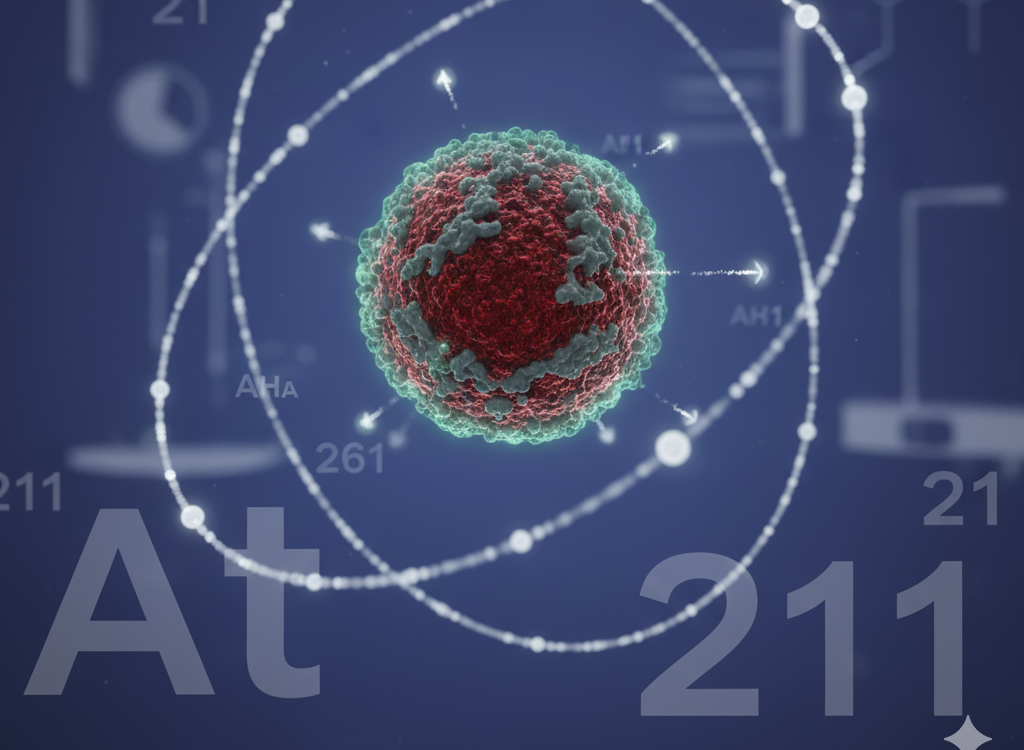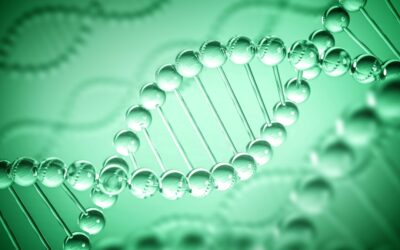Astatine, the heaviest halogen and the rarest naturally occurring element, has long been a scientific curiosity. Among its many isotopes, ²¹¹At has emerged over the past decade as a frontrunner in the quest to harness alpha particles for highly targeted radiotherapy. Recent advances in chemistry, production, and clinical translation are adding momentum to its prospects — though significant challenges remain.
The Appeal of ²¹¹At: Physics, Decay, and Therapeutic Promise
²¹¹At has a half-life of approximately 7.2 hours, a timescale that is long enough to permit multistep chemical conjugation and delivery, yet short enough to limit prolonged radiation exposure.
It decays by two principal routes: about 41.8 % of the time via alpha emission to bismuth-207, and the remainder via electron capture to polonium-211 (which itself decays by alpha emission) en-route to stable lead-207. This simple decay scheme is beneficial: unlike some other alpha-emitters, ²¹¹At does not deliver prolonged daughter radionuclide cascades that might damage surrounding healthy tissue.
Alpha particles deposit large amounts of energy over a very short path (~50–100 µm), making them well suited to killing single cancer cells or small clusters without excessive collateral damage. This spatial specificity, combined with clever targeting, underlies the appeal of ²¹¹At for Targeted Alpha Therapy (TAT).
Chemistry and Labelling: Forging Stable Bonds Under Time Constraints
The chemical behaviour of astatine remains incompletely understood, largely because of its extreme radioactivity and scarcity. Researchers often draw analogies with iodine, its lighter halogen neighbour, but astatine displays significant deviations in bonding and redox behaviour.
A recent breakthrough involved uncovering a robust covalent bond between ²¹¹At and ketone moieties, opening a novel route for attaching the radionuclide to targeting molecules. The strength of this bond can allow more stable conjugation during transport and delivery, while still allowing controlled cleavage under extreme redox conditions.
Radiolabelling strategies have historically centred on electrophilic “astatodemetallation” of aryl tin precursors, adapted from radioiodine chemistry, but this approach often suffers from limited yields and in vivo instability. More recent efforts are exploring electrophilic and nucleophilic At approaches, novel prosthetic groups, and alternative linkage chemistries to improve robustness and expand the kinds of targeting agents that can be labelled.
One lingering challenge is scaling up from tracer-level radiochemistry suitable for preclinical studies into fully automatable, clinically viable methods. Radiolysis, purification, and precise handling under time pressure all complicate the translation.
Production and Supply: Cyclotrons, Transport, and Logistics
Because of the short half-life, ²¹¹At must be produced close to where it will be used. Its principal production route involves irradiating bismuth-209 (²⁰⁹Bi) with alpha particles in a cyclotron, forming ²¹¹At by (α,2n) reaction. An α beam energy in the range of ~28–29 MeV is considered optimal to avoid producing unwanted contaminants such as ²¹⁰At, which decays to highly toxic polonium-210.
A 2023 study described achieving clinically relevant quantities of ²¹¹At, including purification, isolation, and shipment protocols. Another advance involved a new solid phase extraction (SPE) approach enabling faster separation from dissolved irradiated targets, minimizing losses due to the isotope’s rapid decay.
One particularly notable milestone in 2025 was the first successful long-distance transport of a biologically active compound labelled with ²¹¹At—i.e. not just the isotope itself, but a conjugated molecule. The labelled payload arrived without detectable damage from radiolysis, marking a critical step toward distributed production and use of ²¹¹At-based radiopharmaceuticals.
In Japan, researchers and institutions are pushing their cyclotron infrastructure to regionalize production. Osaka University is building a dedicated facility to mass-produce ²¹¹At, and Fukushima Medical University (FMU) has been actively running cyclotrons and initiating early clinical trials. Given regulatory and public challenges surrounding nuclear reactors in Japan, accelerator-based isotope production is now a strategic priority. For example, Osaka’s radiochemist Kazuya Kabayama noted that “Japan’s government … strongly support[s] the development of the five sites that can make astatine-211 using small-scale cyclotron technology.”
Preclinical and Emerging Clinical Studies: Targeting Cancers in Vivo
In the laboratory, ²¹¹At conjugates have been tested in diverse tumour models ranging from prostate and thyroid cancers to glioblastoma. A recent highlight described a locoregional therapy for glioblastoma targeting syndecan-1 (SDC1) using a ²¹¹At-9E7.4 conjugate. That work demonstrated potent tumour suppression and improved survival in preclinical models, reinforcing SDC1 as a therapeutic target.
In Japan, FMU is conducting a Phase I human trial using ²¹¹At linked to a norepinephrine analog for rare neuroendocrine tumours (pheochromocytomas). Results are anticipated in March 2025, which may guide safe dosages and foster transition to Phase II. Meanwhile, Osaka’s team is exploring ²¹¹At-conjugated agents targeting prostate, thyroid, and recurrent iodine-refractory thyroid cancers.
Because astatine lies below iodine in the periodic table, its ionic form can mimic radioiodine behaviour, which is exploited in some thyroid-targeting strategies. A key advantage is that ²¹¹At emits minimal penetrating radiation beyond the target region, reducing the need for patient isolation and radiation shielding compared to beta-emitting radionuclides.
In addition to cancer, some exploratory work is evaluating ²¹¹At approaches in neurodegenerative disease, such as Alzheimer’s, though such uses remain highly experimental.
Challenges and the Path Forward
Despite growing enthusiasm, several obstacles temper optimism:
- Supply constraints remain a major barrier. Because ²¹¹At must be produced close to use sites, broad clinical deployment demands numerous cyclotron-equipped centres with radiochemistry capabilities.
- Radiochemistry scaling: Transitioning from bench-scale tracer labelling to robust, reproducible workflows under clinical Good Manufacturing Practice (GMP) conditions remains a nontrivial engineering challenge.
- Stability and in vivo retention: Ensuring that the ²¹¹At stays bound to the targeting molecule long enough through blood circulation, delivery to the tumour, and internalization is essential to prevent off-target damage.
- Dosimetry and safety: Alpha emitters deliver very potent, localized doses. Careful dosimetry, toxicity profiling, and micro-distribution analysis are required in early human studies.
- Regulatory and logistic hurdles: Licensing, radiation handling infrastructure, and transport constraints (given the short half-life) add layers of complexity.
However, the field is making strides. The successful shipment of a labelled compound in the U.S. is a tangible milestone. Japanese centers are rapidly expanding production capacity. And innovations in chemical conjugation such as the At–ketone bond discovery offer fresh options to improve stability and versatility.
The Journal of Nuclear Medicine recently highlighted ²¹¹At as a radionuclide with compelling near-term potential, especially as investment and production capacity scale up.
If ²¹¹At can overcome its technical and logistical bottlenecks, it may become an essential tool in the next generation of precision radiopharmaceuticals — combining potent α-particle cytotoxicity with tumour-specific molecular targeting.













